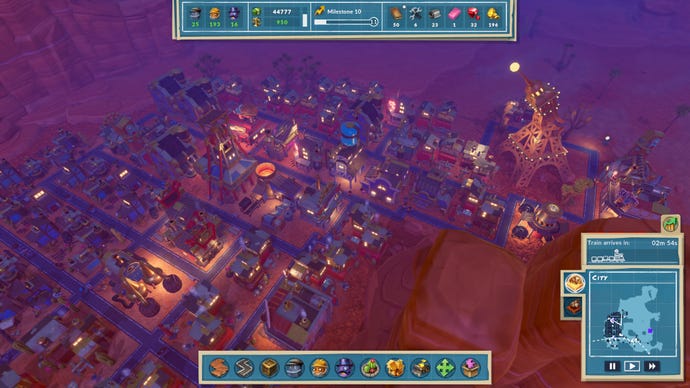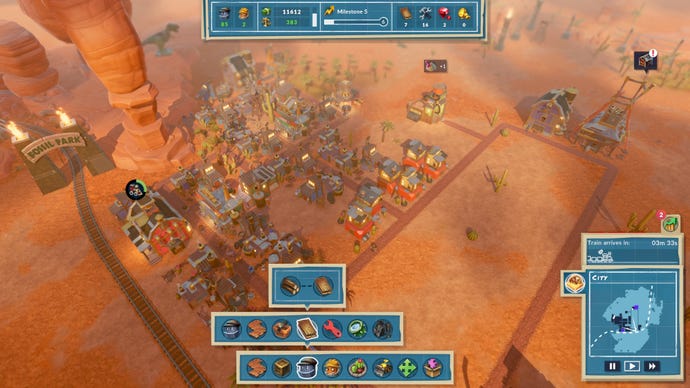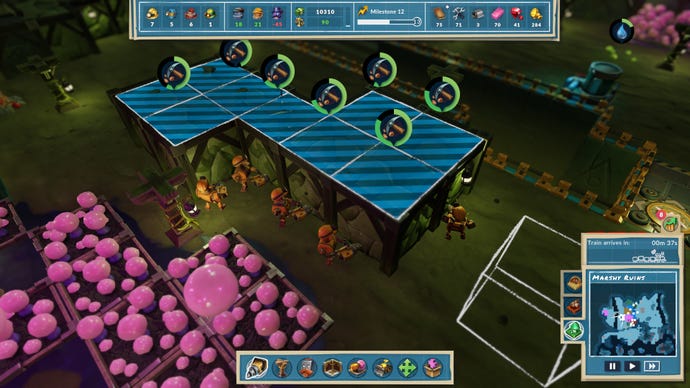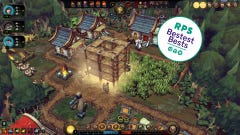SteamWorld Build review: joyful citybuilding and delightful dungeon digging
Ace of spades
In another lifetime, SteamWorld Dig could have easily ended up as SteamWorld Build. When Image & Form first released their 2D digging platformer back in the depths of 2013, its moreish loop of carving out rocky chasms, finding gems and treasure, then upgrading your pickaxe and burgeoning township back on the surface was instantly captivating, and its 2017 sequel continues to be one of my favourite platformers of all time. Now, a decade later, SteamWorld Build has reimagined Dig's core ideas as a handsome citybuilder, placing equal focus on managing your rustbucket town up top, while plundering its depths via an abandoned mineshaft to find treasure, resources and (most importantly) rocket parts, so you can escape your crumbling planet and find a new homestead up in the stars.
Despite the threat of annihilation hanging over the horizon, however, SteamWorld Build is one of the most relaxed and easy-going building games I've ever played. This is a game that's more concerned with keeping your economy running like a well-oiled, uhh, machine than turning a profit, for example, and it merely dips its toe in the genre's wider, ongoing obsession with building up defences to fend off oncoming hordes of malicious town hall-eating nasties. If the scales do get thrown out of equilibrium, the worst that will happen is you get lots of angry little red robot faces appearing above your houses. You won't go bankrupt, you won't get turfed out for being incompetent, and you definitely won't see any kind of game over screen if the aforementioned nasties end up running amok in your mining levels. The stakes, then, are quite low, which is probably a good indication of whether you'll get on with SteamWorld Build, and how much you'll get out of it.
I suspect the more wizened citybuilders among you will probably find that SteamWorld Build doesn't have quite enough bite to hold your attention past an initial playthrough. Still a worthwhile Game Pass candidate, no doubt, but its main problem is familiarity. Indeed, having played on all five of Build's maps (which are all unlocked right at the start), they really just boil down to the same fundamental setting - an orange desert either at night or during the day - with some incidental dressing to give each one a mild bit of flavour. Some old timey movie drive-ins here, some legally distinct Jurassic Park gates and dino bones there, or maybe you prefer a smattering of neon casino signs pointing to nowhere. Grand Gully is perhaps the most ambitious of the lot, with a Grand Canyon-esque gorge separating its two halves, but beyond the slightly different shapes of terrain, the rhythms of building up your town are the same every time. All the buildings are the same regardless of which map you pick, and the milestones you need to reach to unlock newer upgrades play out the same way every time.
There's still a lot of joy to be had within these limitations, I should stress. Every time you zoom in to admire your town's busy streets, you'll find them thrumming with charmingly animated robots of all stripes, from scurrying couriers to swaggering cowbots and even those who disappear inside the rotating brushes of a conveyor car wash. The buildings themselves have a lot of personality to them as well, with giant sawmills tearing up logs, individual cacti getting pulverised for water, and the looming proprietors of each saloon hovering over the entrance like a chrome-plated Al Swearengen. Heck, I even got a kick out of wibbling and wobbling would-be building outlines as I dragged them across the map with my mouse. There are lots of moments like this that make you smile in SteamWorld Build, and it's clear that developers The Station have put a lot of love and care into every little detail, helping to grease the wheels of each and every playthrough.




You see, the main challenge and sense of variety in SteamWorld Build lies underground. While you can technically disable the 'random mine map' from the start menu, the proc gen nature of these subterranean spaces is really what keeps things spicy during subsequent playthroughs. At least to a degree. While the layout and subsequent building challenges of each sub-strata might be different each time, the actual biomes themselves are, once again, the same throughout. You always start with the trad, dusty rock layer, before descending into a dank bog where you'll encounter the first real threats to your operation, until you reach the final, cyber layer where lost machines of the past still reside in sleep mode. Each one is bigger and more dangerous than the last, but once you've knocked together some defences to keep your operation running smoothly, you can feasibly step away from the regular swarm attacks while you turn your focus elsewhere.
In some respects, it's reassuring that SteamWorld Build won't just fall to pieces the moment you turn your back. That's important when your attention is equally divided between above and below, and it would feel rotten in the extreme if everything went belly up on the surface while you were busy directing your miners to dig out precious resources and deal with your ornery neighbours. That SteamWorld Build still manages to exert some pressure under these circumstances is commendable, and it does a great job of flagging up unseen threats such as imminent cave-ins or those aforementioned bug/bot attacks to keep the tension humming away in the background.

The two layers are inextricably linked, with resources below often being vital to the construction and running of buildings and facilities above. The most important resource, however, is your population, as you'll need enough workers, miners, posh aristobots and eventually scientists to keep all of these enterprises running smoothly and keep your economy afloat - and if you don't keep them happy by building the necessary class-specific stuff to keep them satisfied, you'll quickly find the scales getting increasingly unbalanced, leading to staff shortages, slower resource generation and progress grinding to a halt.
The staff shortages do tickle me slightly. The idea of a robot being so upset they're not within spitting distance of a burger joint that they refuse to go to work can't help but make me chuckle sometimes, but it is also arguably one of SteamWorld Build's biggest sticking points. You see, a house doesn't generate a set number of bots. Instead, the number varies by how happy they are and whether all their needs are being met, and with new happiness-critical buildings being added all the time as you move up the game's milestones, it can lead to some quite sudden (and at times frustrating) shortfalls when you least expect it.




This rug pull sensation gets compounded when you suddenly start losing money, too, either because the cost of keeping up your mine now exceeds the tax income generated by your robot population, or because falling happiness levels means you've suddenly got a deficit of free workers unfolding, which in turn means you can't staff all those critical buildings you need to keep those happiness levels topped up. Fortunately, there are measures available to stop it spiralling completely out of control, helping to keep any feelings of panic firmly at bay. You can use your train station to make trades, for example, selling off spare resources for cash and other items to get yourself back on your feet, or you can also demolish buildings to gain back some of the cost you initially put into them. I rarely had to resort to this, though, as I often found trading was more than enough to get the job done without having to undo all my hard work. There's also an exceedingly generous free move tool that lets you swap buildings around very easily to try and arrange things more efficiently.
Again, some may find these concessions a bit soft compared to harder-edged citybuilders, but I, for one, appreciated the additional safety net. The ease with which you can right its often ailing ship makes SteamWorld Build very approachable, and I'm sure I'd had been turfed out multiple times Frostpunk-style if Build wasn't so accommodating. That's not to say it's a completely easy ride, however. The pacing really ramps up in the latter stages of your rocket part excavation, for example, with timed hordes descending the moment your team of miners start digging them up, and when you're fending off attacks from multiple fronts simultaneously toward the end, you could almost believe you're playing a tower defence game (harking right back to SteamWorld's original pre-Dig DSi roots, of all things) instead of a citybuilder.



You really do go through quite a journey over the course of ten hours or so. It's just that the next ten hours will likely be very similar when you start up afresh on a new map. To some, that sense of easy familiarity will be a welcome relief. To others, however, it will likely descend in a kind of dreary tedium - and no amount of metallic Deadwood stand-ins will cure that. If you're likely to fall into that latter camp, I'd still urge you to at least give it a playthrough on Game Pass, as there really is a lot to like and admire here.
But I do worry about whether Build has enough gas in the tank to keep players coming back for more as time goes on. I already feel like I've had my fill of it, for example, and when each map is mostly more of the same, there's little incentive (or indeed capacity) to try things differently. Decoration items are available, but never needed, for example, and the path to success always lies in ruthless efficiency. There's nothing wrong with that in itself, of course, but for a series that's always excelled at feeding players' imaginations - from sniping off hats in SteamWorld Heist, mixing magic cards in SteamWorld Quest, or speedrunning its platform challenges in Dig 2 - Build just lacks that spark of creativity to launch it into SteamWorld stardom.
This review is based on a retail build of the game provided by publishers Thunderful.










